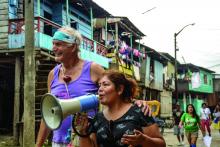Ever had a patient who not only got better but used the insights she gained from talking with you to help others in distress? I have just such a patient in the Peruvian Amazon.
I’ve previously written about an annual clown trip to Peru that I make with my friend Patch Adams, MD, and 100 other humanitarian clowns from all over the world. We have been going there for a decade to spread cheer, and revitalize the impoverished community of Belén, which is situated in the Amazon floodplain in the city of Iquitos. We conduct workshops, perform street theater, create community art installations, visit hospitals, and work with local grass-roots organizations. For the last 5 years, we also have been conducting mental health clinics in the streets.
To provide a brief overview ... we go to a neighborhood, set up our space, and walk the streets with a bull horn. We announce our presence – “we are mental health professionals, and we’re meeting over at” ... and we talk with anybody, young and old, who wants to discuss health problems, family issues, or other concerns.
We sit in a public place and speak to individuals/couples/families for 20 minutes, while around us, support clowns entertain the kids. We neither make diagnoses nor give drugs; we come with a clown nose and an open heart, and we listen actively without judgment and focus on solutions. We help people identify their strengths and resilience, and give them practical advice. This is community psychiatry disguised as “clown therapy,” which is just another phrase for solution-oriented therapy/ positive psychology/reality therapy/resilience-based therapy, logotherapy, existential psychotherapy, or kitchen table wisdom. These street clinics have had a profound impact on patients and clinicians.
Three years ago, I met a middle-aged woman who was suicidally depressed, and together we negotiated a successful intervention. In summary, she emerged from a church that happened to be across the street from where we were setting up our clinic. A clown saw her weeping and approached her, and after talking with her assured her that there was somebody here right now – a mental health professional – who would talk with her.
Maria sat down and told an unbelievably painful story that was happening within her family. On that day, after 8 months of prayer and receiving no sign from God, she had decided to kill herself. After listening to her, I actually believed she could do it.
There are no treatment centers or emergency shelters for the poor in Belén, so at our closure, I made her promise that she would not try to kill herself until I could see her again at our next clinic 2 days away, and close by. I gave her an amulet that was blessed and told her it was a reminder of her promise, and that my smiling face would be with her until she saw me again. She returned with her daughters to the next clinic, and together, they found a way to take a step forward.
Last year, I made my first home visit, and met with Maria, her daughters, and new grandson in their “new” home where they were happily sustaining themselves . When I left, the love and appreciation was so overwhelming that I told them as long as I returned I would come visit every year.
I just got back from this year’s annual visit, and was again greeted with passionate tears of joy. We sat and talked, and Maria told me her story. It seems that people in the community were now coming to her as a resource when they were deeply depressed. People know that she had walked a similar path and moved beyond it.
She is a warm, good listener, and tells them a story about walking out of church and deciding she wanted to kill herself, and meeting with a tall gringo, a clown/doctor who miraculously saved her life. She gives them simple, practical advice, tells them how important it is to stay connected to their children, speak your truth with them openly; to pray for miracles and recognize them when they occur. She tells them to reach out for help, and people will reach out to them. She is a credible, inspiring friend who gives hope.
For those who remember when community psychiatry was actually a subspecialty, this is my vision of community mental health: People talking to credible witnesses/healers/resources in their community, whom they respect, who will listen without judgment, and maybe even say something that inspires a light in the darkness. It’s at least as effective as psychotropic drugs, and all its benefits come without side effects.
Once a year we come together, listen to each other’s stories, and continue our healing work together. Maria tells me her friends want to meet me. “They want to steal you away,” she says, “but I tell them I am not afraid.”
Maria, a lay therapist of sorts, is the community mental health consultant. Once a year, she consults with her gringo, the clown/doctor, to compare notes. We laugh and love, hug and cry, and give each other hope. No matter how divisive and polarizing the times, it is possible to come together in community and promote healing.
Dr. Hammerschlag is chief of community mental health of the Gesundheit! Institute and a faculty member at the University of Arizona, Phoenix. He is the author of several books on healing and spirituality, including “Kindling Spirit: Healing from Within” (New York: Turtle Island Press, 2010) and “The Dancing Healers: A Doctor’s Journey of Healing With Native Americans” (San Francisco: Harper, 1988). Dr. Hammerschlag’s website is healingdoc.com.


